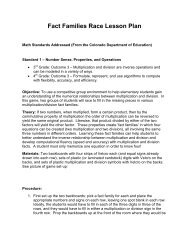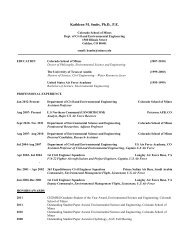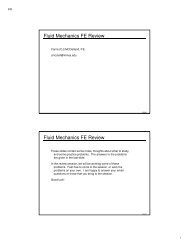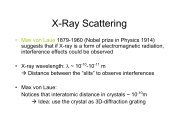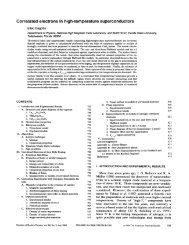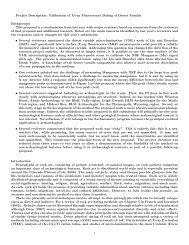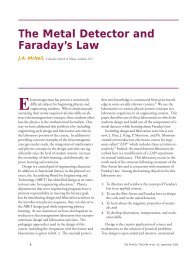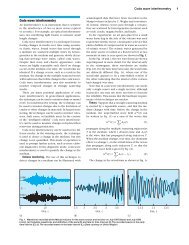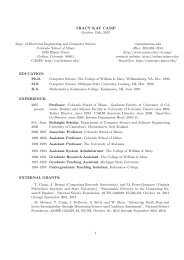Debris Basin and Deflection Berm Design for Fire-Related Debris ...
Debris Basin and Deflection Berm Design for Fire-Related Debris ...
Debris Basin and Deflection Berm Design for Fire-Related Debris ...
Create successful ePaper yourself
Turn your PDF publications into a flip-book with our unique Google optimized e-Paper software.
<strong>Debris</strong>-Flow Mitigation <strong>Design</strong><br />
Figure 8. Downstream view of the Buckley Draw deflection berm near Provo, Utah, after a small debris flow (from Elliot, 2007).<br />
was used <strong>for</strong> the design of the Buckley Draw<br />
deflection berm. A bulking factor was then applied<br />
to the clear-water discharge to account <strong>for</strong> the debrisflow<br />
peak discharge. For Buckley Draw, a bulking<br />
factor of approximately 1.4 was used. This bulking<br />
factor was estimated using an unpublished Engineering<br />
Technical Note developed by the NRCS in New<br />
Mexico that discusses soil erodibility. Additional<br />
conservatism <strong>and</strong> freeboard were added to the berm<br />
height above that required to pass the design<br />
discharge. Superelevation heights were also considered,<br />
<strong>and</strong> the upstream side of the berm was armored<br />
with large rocks (Rogers, 2007).<br />
Structures designed using this methodology have<br />
settled out coarse material from debris flows, with<br />
only water <strong>and</strong> some fines exiting the structure<br />
(Rogers, 2008).<br />
PROPOSED CHANGES TO THE STATE OF<br />
PRACTICE FOR DEBRIS-FLOW DEFLECTION<br />
BERM DESIGN<br />
As with the critique of debris-flow basin design, the<br />
few published designs <strong>for</strong> debris-flow deflection berms<br />
are assumed to represent the state of practice in general.<br />
These published designs represent the <strong>for</strong>efront of a<br />
field that is newly developing, <strong>and</strong> the comments below<br />
are aimed at improving the state of practice <strong>and</strong> not at<br />
disparaging these designs.<br />
Discussion<br />
Because Oregon’s Department of Forestry policy of<br />
developing conservative deflection berm designs from<br />
qualitative judgment is, by definition, subjective, it<br />
may be difficult to assess exactly what constitutes a<br />
conservative design. In order to deem a design<br />
conservative, one must have an idea of the berm size<br />
that is required to provide debris-flow control. This<br />
knowledge may come from the precedent of the<br />
successes or failures of previous structures or from a<br />
quantitative estimate of the characteristics of a design<br />
debris-flow event. Upcoming sections provide a<br />
methodology <strong>for</strong> the quantitative design of debrisflow<br />
deflection berms.<br />
Although the NRCS designs deflection berms <strong>for</strong> a<br />
quantitative discharge, the reliance on an erodibility<br />
study from New Mexico introduces some variability.<br />
First, the applicability of this study to Utah is difficult<br />
to prove because of possible geologic, meteorologic,<br />
<strong>and</strong> vegetative differences between the two states.<br />
Second, it is uncertain whether the New Mexico<br />
erodibility study considered scouring effects of debris<br />
flows or if it was only applicable to the bulking of<br />
sediment into normal stream flow. Bulking rates<br />
observed once debris flows occur will be higher than<br />
those associated with clear-water flow due to the<br />
increased shear stress caused by a higher fluid density<br />
(Hungr et al., 2005).<br />
Environmental & Engineering Geoscience, Vol. XIV, No. 4, November 2008, pp. 297–313 307



